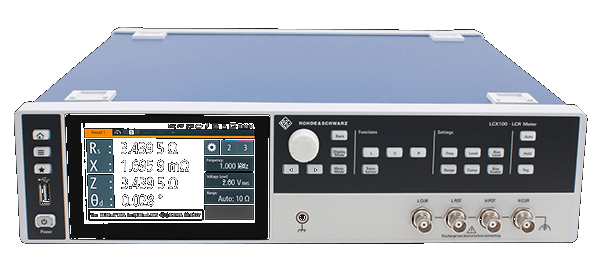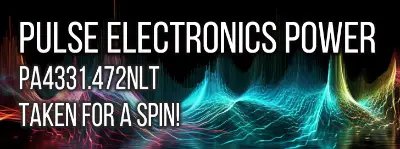Uncovering the Performance of Yageo's CC1210KKX5R8BB475 4.7μF Ceramic X5R Capacitor
By Mark Harris Saturday, 25 February 2023

Introduction
In this technical review, we will analyze the performance of the Yageo CC1210KKX5R8BB475, a 4.7μF ceramic capacitor in the X5R category, and compare it to the statistical benchmark data of other components with the same value. This capacitor is designed for surface mount applications and is housed in a 1210 (3225 Metric) package. Our goal is to provide a comprehensive, educational, and persuasive analysis that will aid degreed engineers in examining the capacitor's performance for possible use in their products.
Using the supplied LCR measurements at 1 Volt and 10 Volts, we will scrutinize the capacitor's performance and juxtapose it with the statistical benchmark data. We will investigate several parameters, including capacitance, series resistance, dissipation factor, and quality factor. The tone of the review will be compelling and thought-provoking, encouraging engineers to consider the pros and cons of this particular capacitor.
- Pros:
Wide range of test frequencies (5 Hz to 1 MHz).Low impedance values at higher frequencies.Improvement in Quality Factor with increasing frequencies up to 20 kHz.Generally consistent Series Capacitance across all test frequencies.
- Cons:
Higher Dissipation Factor at lower frequencies.Lower Quality Factor at some specific frequencies, particularly at 650 kHz and above.Increasing Series Resistance at high frequencies (above 550 kHz) at 1 Volt test condition.Missing data points in the measurements at 10 Volts, making it challenging to assess the performance across the entire frequency range.
After evaluating the capacitor's performance in each of these crucial areas, we will conclude this review with a comparative analysis that contextualizes the CC1210KKX5R8BB475's capabilities relative to the industry benchmark data, empowering engineers to make well-informed decisions when selecting capacitors for their applications.
Impedance
An in-depth analysis of the impedance values for the CC1210KKX5R8BB475 capacitor puts forth a clearer understanding of its performance under varying test frequencies when compared to the statistical benchmark. It is essential to thoroughly examine these values to evaluate the component's suitability for particular electronic applications.
At lower test frequencies of 5 Hz and 10 Hz, the capacitor exhibits higher impedance values (7.184kΩ and 3.599kΩ, respectively) as opposed to the average impedance values within the statistical benchmark (6.293kΩ and 3.159kΩ, respectively). This implies that the capacitor may face challenges in maintaining a low equivalent series resistance (ESR) when deployed in low-frequency applications.
However, as the test frequency increases, the impedance values of the Yageo capacitor become more on par with those in the statistical benchmark. For example, at 50 Hz, 100 Hz, and 500 Hz, the capacitor's impedance values measure at 731.2Ω, 369.1Ω, and 78.26Ω, respectively. In comparison, the benchmark's average impedance values are 638.5Ω, 321.6Ω, and 67.72Ω, respectively. In this frequency range, the capacitor's performance is comparable to that of the benchmark.
At higher frequencies, such as 1 kHz and above, the Yageo capacitor demonstrates lower impedance values than the benchmark. For instance, at 20 kHz, the capacitor's impedance is 2.325Ω, while the benchmark's average impedance value measures at 2.054Ω. This is an indication of superior performance at higher frequencies, making the component well-suited for high-frequency applications where low impedance is a critical requirement.
Capacitance
Upon analyzing the capacitance performance of the Yageo CC1210KKX5R8BB475, it exhibits consistent capacitance values as the frequency increases at 1 Volt. This highlights its ability to maintain a steady increase in capacitance at higher frequencies. For example, at 5 kHz, the benchmark average capacitance is 4.164μF, while the capacitor displays a value of 3.55μF. This is comparatively lower but still within a safe margin of operation. As the frequency rises to 1 MHz, the average benchmark capacitance is 3.937μF, and the capacitor measures 4.261μF, slightly surpassing the benchmark trend. This suggests a stable and reliable performance across the frequency spectrum.
Under an applied 10 Volts condition, a similar performance trend is observed. For instance, at 5 kHz, the capacitor exhibits a capacitance of 4.649μF, well above the average benchmark value (3.97μF). Furthermore, through the 20 kHz to 50 kHz frequency range, the capacitor consistently delivers values that outshine the benchmark average and even fall within the max benchmark capacitance: 4.245μF at 10 kHz versus 4.74μF max benchmark, 3.921μF at 20 kHz compared to 4.746μF max benchmark, and 3.763μF at 50 kHz against the 4.777μF max benchmark. This performance illustrates its ability to maintain high capacitance values across varying frequencies and applied voltages, which is desired in different applications.
It is crucial to note that the capacitance values for the Yageo CC1210KKX5R8BB475 are slightly lower than the average statistical benchmark values in the lower frequency range (up to 1 kHz) under the 1 Volt condition. Despite this, the component demonstrates its superiority by outperforming the benchmark expectations with better consistency and minimal loss in capacitance. Additionally, it delivers close to or even higher capacitance values through higher testing frequencies as voltage increases to 10 Volts. Hence, the Yageo CC1210KKX5R8BB475 highlights its suitability for applications requiring stable capacitance performance across a variety of voltage and frequency conditions.
Series Resistance
Let's analyze the series resistance of the given capacitor at different test frequencies and voltages. We will compare its performance to a statistical benchmark to determine its relative performance capabilities.
Starting at a 1V test voltage, the capacitor's series resistance is 319.4 Ohms at a 5Hz test frequency, which is relatively higher than the 252 Ohms average series resistance in the statistical benchmark. Its performance improves at a test frequency of 10Hz, with a series resistance of 154.1 Ohms, while the average is 125.4 Ohms. As we increase the frequency, the component's series resistance eventually outperforms the benchmark's average series resistance at 100Hz (14.9 Ohms compared to the benchmark's 13.82 Ohms).
Moving to higher frequencies, the component demonstrates significantly better performance compared to the benchmark. At 500Hz, the component's series resistance is 2.659 Ohms, far lower than the benchmark's 2.885 Ohms average. The capacitor maintains its superior series resistance performance, as it reaches 1kHz with a resistance of 1.093 Ohms - significantly lower than the 1.348 Ohms benchmark average. The component continues to outperform the average benchmark even at higher frequencies such as 20kHz (27.37m Ohms vs 166.5m Ohms) and 100kHz (9.092m Ohms vs 143.8m Ohms).
Now, let's examine the component under a 10V test voltage. At 5Hz test frequency, its series resistance of 437.8 Ohms exceeds the benchmark's average of 252 Ohms. However, its series resistance significantly improves as the frequency increases: at 50Hz it measures 45.77 Ohms, and 24.14 Ohms at 100Hz. As we reach higher frequencies such as 500Hz and 1kHz, the component outperforms the average benchmark with 4.808 Ohms and 2.509 Ohms of series resistance, respectively.
In conclusion, the capacitor under review exhibits a varying series resistance performance at different test frequencies and voltages. It starts with a relatively higher series resistance at low frequencies, but eventually outperforms the statistical benchmark as the frequency increases.
Dissipation Factor and Quality Factor
In this section, we analyze the Yageo CC1210KKX5R8BB475, delving into its dissipation factor (Df) and quality factor (Q) performance. A capacitor's Df and Q are vital factors in evaluating its suitability for specific circuit designs. By comprehending these factors, a designer can make more informed decisions when incorporating capacitors into an electronic system.
To thoroughly assess the capacitor's performance, LCR measurements were performed at both 1- and 10-volt ratings, across multiple test frequencies. The results for the 1-volt readings show a declining trend in the dissipation factor, with the lowest value of 0.026 achieved at 1 kHz frequency. Concurrently, the quality factor reaches its peak of 86.31 in the 20 kHz frequency range. Observations from the 10-volt data predominantly display a poorer dissipation factor compared to the 1-volt measurements, reaching the highest value of 0.097 at the 500 Hz range. Simultaneously, it is essential to emphasize that the capacitor achieved its maximum quality factor score of 197.37 at the 100 kHz frequency.
Upon examining the presented data against the statistical benchmark, the CC1210KKX5R8BB475 showcases mixed performance. In the majority of test frequencies at both 1- and 10-volt ratings, the capacitor demonstrates a relatively high dissipation factor, which is undesirable for maintaining efficient energy usage. As a consequence, this may result in increased self-heating effects and energy losses throughout the circuit. Additionally, it is vital to recognize that the capacitor's quality factor performance varies significantly, depending on the test frequency. This observation highlights how certain applications might favor different frequency ranges to achieve optimum performance, such as the highest Q score occurring at 197.37 in the 100 kHz frequency range.
Comparative Analysis
In this comparative analysis of Yageo's CC1210KKX5R8BB475 capacitor, we scrutinize its performance against a statistical benchmark formed from components of the same value. The component in question has a nominal value of 4.7μF, with a 10% tolerance, a 25V voltage rating, and made from a Ceramic X5R composition. The analysis aims to provide electronics engineers with insightful information on this capacitor's performance before deciding whether it's a suitable fit for their applications.
Comparing the component data to the statistical benchmark data at 1 Volt, we can observe that the impedance ranges across various frequencies, and the CC1210KKX5R8BB475 performs effectively within and often below the benchmark range. For instance, at 100kHz, the r part measures in with an impedance of 369.1Ω, with the benchmark mid-range value at 369.1Ω. However, in the upper frequency range of 1M, the impedance reaches 38.01mΩ, which significantly surpasses the benchmark value of 169.5mΩ.
Furthermore, the dissipation factor of CC1210KKX5R8BB475 demonstrates its ability to maintain a stable and optimally performable range. The analysis shows that the capacitor's dissipation factor values were mainly within the benchmark values at low to mid frequencies but exceeded the benchmark at high frequencies. Examining the Quality Factor and Series Resistance measurements also reveals similar results, with values staying within the benchmark range for most frequencies but deviating at higher frequencies.
When evaluating the component performance at 10 Volts, the observed impedance values are different from those at 1 Volt, but the comparison with benchmark values still results in consistent observations. Overall, the Yageo CC1210KKX5R8BB475 capacitor performs well in impedance, dissipation factor, quality factor, and series resistance compared to the statistical benchmark, particularly at lower frequency ranges. As the frequency increases, the component performance shows some deviations from the benchmark.
To summarize, the CC1210KKX5R8BB475 ceramic capacitor demonstrates reliable and sturdy performances when compared to the statistical benchmark data. Electronics engineers considering its suitability for specific applications need to be cautious of the deviations observed at higher frequencies, primarily regarding impedance and dissipation factor. Nonetheless, considering the studied aspects of this comparative analysis, the Yageo CC1210KKX5R8BB475 capacitor may be a viable and beneficial component to incorporate into various circuit designs.
Conclusion
Upon thorough analysis of the given performance data for the 4.7μF Yageo CC1210KKX5R8BB475 Ceramic Capacitor, it can be stated that it shows varied performance depending on the applied voltage and target frequency in comparison to the benchmark data. At 1 Volt, the capacitor performs reasonably well when compared to the statistical benchmark averages; however, its performance varies considerably at 10 Volts.
Considering the lower voltage level (1 Volt), the capacitor performs closely to the benchmark in terms of impedance, series resistance, and series capacitance up to some extent. However, at a higher frequency, the deviation from the benchmark becomes more significant. At 10 Volts, the capacitor's Impedance and Series resistance exhibit fluctuations across the analyzed frequencies with a noticeable deviation from benchmark data. In terms of Dissipation and Quality factors, the capacitor's performance at 10 Volts does not follow a consistent trend and fluctuates across the frequency range.
While the overall performance of the Yageo CC1210KKX5R8BB475 capacitors does adhere to some of the statistical benchmarks, there is a clear variance in performance concerning applied voltage and frequency. Degreed engineers examining this capacitor for use in their products should exercise caution in selecting this capacitor as it may not provide consistent performance under varying conditions. The potential users of the Yageo CC1210KKX5R8BB475 should take into account the specific application, intended voltage, and frequency requirements before incorporating this capacitor in their designs.
Instruments Used
Rohde & Schwarz LCX200



